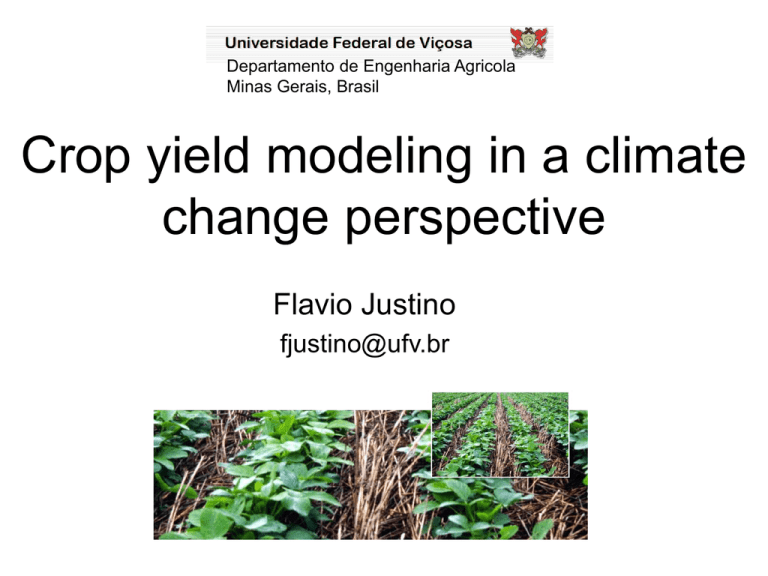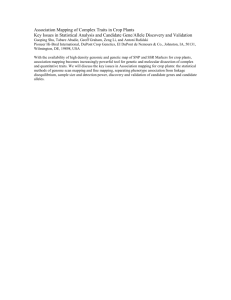Crop yield modeling in a climate Flavio Justino
advertisement

Departamento de Engenharia Agricola Minas Gerais, Brasil Crop yield modeling in a climate change perspective Flavio Justino fjustino@ufv.br Outline 1. Background 2. Conceptual Crop Models and the DSSAT Crop Model 3. Climate Projections 4. Crop Yields 5. Amazon Region 6. Africa 7. Future Directions Food Security The looming crisis Rising global population - from 6 to 9 billion by 2050 - already more people in urban than rural areas - changing diet: more demand for meat & dairy For the first time in human history more people now live in towns and cities than in the countryside Water use in cubic metres per Kg of product 7000 Urban population 16 6000 14 Rural population 5000 12 10 4000 8 3000 6 4 2000 2 0 1000 Beef 2050 2040 2030 2020 2010 2000 1990 1980 1970 1960 1950 0 Lamb Cereal Economic Growth • Middle class increase • Changing habits China Climate Risk 6 Crop modeling approach Soil Water Management Weather N Application + Organic Crop (Genetic Coefficients ) Duration of Phases Development Photosynthesis Respiration CO2 Mass of Crop Kg/ha Leaf Stem Growth Partitioning Root Fruit INPUTS File x Experimental Data File File S File w File C Soil Data Weather Data Cultivar Code Crop Models File A Crop Data at Harvest File T Crop Data during season Output Depending on Option Setting and Simulation Application Crop modeling complexity Complexity Availiabity of data Experiments Model development CO2 effect Technological effect MAIZE CLIMATE CO2 + Climate CO2 + Climate + Technology 2020 2050 2080 DSSAT (Crop Model) • DSSAT: Decision Support System for Agrotechnology Transfer • DSSAT: a microcomputer software program combining crop soil and weather data bases and programs to manage them, with crop models and application programs, to simulate multi-year outcomes of crop management strategies. • DSSAT allows users to ask "what if" questions and simulate results by conducting, in minutes on a desktop computer, experiments which would consume a significant part of an agronomist's career. Amazon Basin • High Pressure to Crop Area Enlargement • Soybeans and Maize • Modeling Input – Climate data (Hadley Centre Regional Model) • Tx, Tm, Rg, Wind and Prec – Optimum soil managements – CO2 fertilization effect – Thermal and water stress Climate Projections Maize Phenological Cycle Productivity A2 B2 (Kg/ha) Grain yield (%) -70 -65 -60 -55 -50 -45 -40 -35 -30 -25 -20 -15 -10 Soybeans – Phenological Cycle Crop cycle (%) -40 -35 -30 -25 -20 -15 -10 -5 0 +5 +10 +15 +20 Real Productivity Grain yield (%) -60 -50 -40 -30 -20 -10 0 +10 +20 +30 +40 +50 +60 Africa • RegCM3 Climate data – A1B IPCC scenario – Tx, Tm, Rg, Wind, Prec – 50 Km x 50 Km --- Changed to 150 Km • Modeling Input – Climate data • Tx, Tm, Rg, Wind and Prec – Optimum soil managements – CO2 fertilization effect – Thermal and water stresses Potential and Actual Projection 2011-2030 No water deficit Water deficit Potential and Actual Projection 2071-2090 No water dependance Water dependance Is sorghum an alternative? • Semi-arid region Regular precipitation Future X present Future X present Temperature and CO2 effects A new player, O3 Atmospheric Environment 43 (2009) 604–618 To validate: Experiments Exp (conti) Further Developments • Similar study to: – Wheat – Evaluation of the effect of ozone on crops • Wheat, soybeans, maize – Coupling DSSAT to Century • Carbon balance and fertilizer effect due to crop implementation



